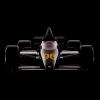Interesting. It’s a lot more “hollow” than I expected.
PaYR,
Because of owning an image like this I rated myself to know at least a little bit about the car. But since things went out of control between the two of us I didn't want to go into it in more details. But on that picture you posted in wich you put the red circle as of the creators of the vortices, that little opening is actually the entry for the `underwing-like` tunnels under the car.
As I was told in the past and as I understood it: the main principle for the BLAT cars wasn't so much generating downforce by accellerating the air under the car as fast as possible like on a `conventional` wingcar, instead the downforce was primarily the result of trying to keep the vacuum under the car as high as possible due to small air entries but a big diffuser to create that vacuum. But the success of retaining that vacuums was with the creation of the vortices next to the car.
Still, the underside being as hollow as it is, there are still some simularities with regular wing cars. Because I was aware of that, that caused my comments about the car looks such and inefficient design on first sight, but that is when compared with genuine wingcars. And that was what I did.
That makes it look a lot more like a couple of weirdly shaped venturi tunnels. I can't see any evidence of the two inlets, interestingly...
Also congrats Ensign - that is a highly specific image to have magicked up in 64 minutes.
At this picture is is difficult to see but go up to that post #23 by PAYR in which a red circle appears when seeing the car from up front. That tiny square next to the cockpit is the entry to the tunnels you see on Ensign's picture.
BTW, I think that the car we see in Ensign14's image is the 1980 version of the car, not the 1981/1982 version
Edited by Henri Greuter, 17 July 2020 - 16:55.



















